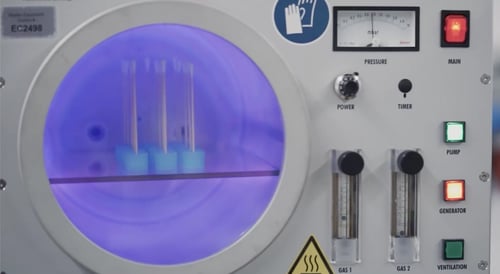
Contact angle, Test Inks or Cross-cut tests
The contact angle is the angle that is formed when observing the projection of the drop lying on the solid by the tangent to the drop contour with the surface of the solid in the three-phase point. According to the physical definition, a surface with a contact angle smaller than 90° is hydrophilic (wettable), and larger than 90° hydrophobic (non-wettable). The contact angle can be changed (increased or decreased) by means of plasma treatment. A suitable plasma process or application of a suitable coating in a plasma process enables hydrophilic in Convert hydrophobic surfaces (vice versa through hydrophilic layers).
Measuring device for estimating the surface energy: If the test ink contracts after application to the surface, the surface energy of the solid is lower than that of the ink, if the wetting is retained, the surface energy of the solid is equal to or greater than that of the liquid. By using series of test inks with graduated surface energy, the total surface tension of a solid can be determined. The polar and non-polar proportion of surface energy can not be determined with this method .
The adhesion of coatings to check, one is cross-cut test (standards: DIN EN ISO 2409 and ASTM D3369-02) performed. After painting, the lacquer layer of the plastic part is cut into a grid. Then a standardized adhesive tape is glued to the cutting grid, pressed on and pulled off again with a jerk . If you paint the tape hanging , the adhesion of the coating is defective. The cross-cut shows the adhesive strength of layers of paint on plastic parts.
To learn more about the use of plasma in manufacturing, please read our eBook titled "Manufacturer’s Surface Activation Guide for Improved Adhesion."
Plasma: +1 (248) 761 9253
Distribution: +1 (248) 549 8600
Fax: +1 (248) 549 3533
info@thierry-corp.com